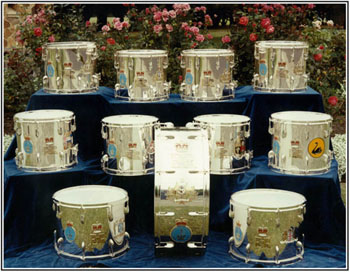
The Ceremonial Silver Drums
Thanks to Robin Himbury, the Silver Drums now have their pride of place in the history of the Royal Australian Navy Band. Through his book, "The Evolution of the Royal Australian Navy Band", the whole story is there for past and present members of the Band and public to read. This is his story.
The Ceremonial Silver Drums
FOREWORD BY ROBIN HIMBURY.
I felt quite honoured when Errol Hatch asked if he could use material from my book “The Evolution of the Royal Australian Navy Band”, in particular, the chapter covering the ceremonial silver drums to upgrade the Association’s website. These instruments were the main catalyst for years of research prior to publication.My affinity with the Drouyn & Drouyn Company goes back to 1952 when as an aspiring drummer my parents bought me an orchestral “Dandy” snare drum. In late 1963 as a Percussionist with the RAN East Australian Area Band on tour in Brisbane, I accompanied CPO Frank Lunn to the Drouyn factory to inspect the silver drums as they neared completion before they were presented to the Navy.On 6 December 1963 I was the recipient of the NSW state tenor drum at a formal ceremony in Sydney. The following week the band travelled to Brisbane where I was the recipient of the Queensland state side drum.In September 1964 I was a member of the Navy Band that took part in the British Military Tournament and Tattoo at the Sydney Showground. This was the first time that all the drums had been paraded as part of a ceremonial drill display.The ceremonial silver drums form an integral part of the RAN Band History of which I am personally proud to have been involved in a very small way.Rob HimburyKillcare Heights18 March 2012Drums:
The drum is a member of the percussion family, possibly the oldest of the instrumental groups. Its origin can be traced back thousands of years to African and Middle Eastern roots.
The maritime connection with this instrument is personified in Sir Henry Newbolt’s poem ‘Drakes Drum’, a reference to the leadership qualities of Sir Francis Drake 1541-1596:
Another military association is the ‘Drum Head Court Martial’ where an upturned drum was used as a table for the trial of offences committed during military operations.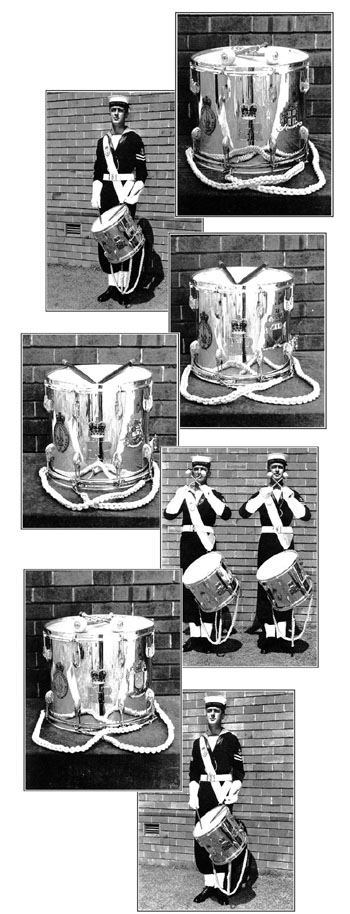
To be drummed out:
When a disgraced soldier was dismissed from the regiment he was ‘drummed out’ through the ranks to the accompaniment of drum beats.
The parade drums in use today have evolved since Louis XIV and Frederick the Great combined them with brass and woodwind instruments in the 17th century.
Research through history shows that in 18th century Europe, native African time beaters and drummers were used to complement military bands.
British Military Bands adopted the wearing of tiger or leopard skins by the bass drummer as a relic of the days when the native African drummers who were often slaves, were dressed exotically in animal skins. When Earl Mountbatten was sworn in as Viceroy of India 24 March 1947, the Maharajahs presented him with 30 of the best tiger skins they had collected for presentation to The Royal Navy whose bands were provided by the Royal Marines. The Royal Marines kept most but distributed others to The Commonwealth Naval Bands. The tiger skin used by the Flinders Naval Depot Band in the early 1950s was shot by the Maharajah of Bikaner (North Western India near the Pakistan border).
In 1965 the High Commissioner for Malaysia, Tun Lim Yew Hock presented a tiger skin to the Royal Australian Navy Band.
The standard parade drum used by the RAN is 14 inches (36 cm) in diameter and 14 inches (36 cm) deep.
The drum heads were originally animal skins which had been especially tanned. They were of parchment or calf skin. However they were extremely susceptible to moisture and generally unreliable in extreme weather conditions. In the late 1950s, a plastic drum head was developed by Remo Belli in The United States (thus the Remo Brand) which was instantly accepted.
The method of tensioning the drum evolved over the years until the early 18th century when ropes threaded through both counter hoops were tightened by buff leather lugs.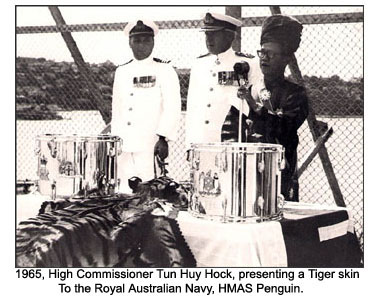
The RAN bands used rope tensioned drums until 1958 when rod tension drums superseded them. The original rod tension drums
issued were of basic design but in the early 1960s the ‘Premier’ parade drum was issued to all RAN bands.
The embellishments on the shell of the drum have changed from ‘RAN’ to an anchor decal. The drums now in use, issued in the
1970s, feature The Commonwealth Coat of Arms and Battle Honours.
The drum was the main method of conveying orders on the battlefield or at sea and used to recall troops at the end of the day. As
discussed in the previous Chapter, beating Retreat or Beat to Quarters is used today as a ceremonial feature utilizing the drum and
bugle corps.
The Ceremonial Silver Drums
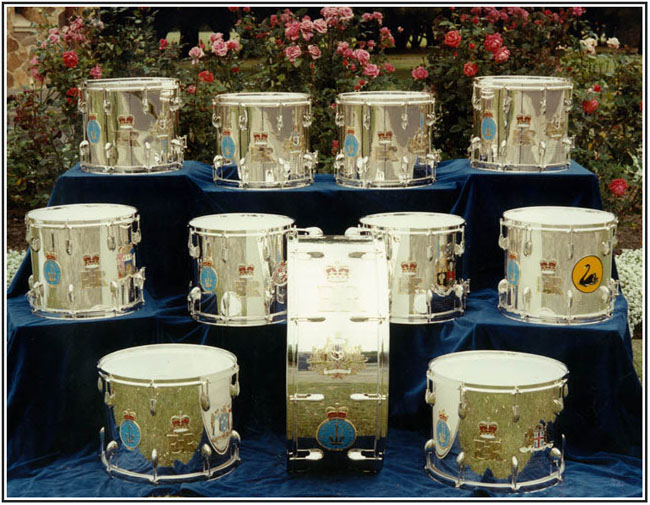
A specially commissioned set of ceremonial silver drums was presented to the RAN Band by The Commonwealth and States of
Australia to mark the 50th Anniversary of the Royal Australian Navy. The chronological process leading to the presentation of these
drums can be established from the National Archives of Australia pertaining to ‘The Gift of Silver Drums to the RAN Band’.
In 1961 the RAN celebrated its Golden Jubilee and the concept of marking this anniversary with a set of silver drums was mooted. It is recorded that various state governments were approached by ‘a Senior Naval Officer’, possibly Flag Officer Commanding Australian Fleet (FOCAF) Rear Admiral WH Harrington CB DSO, to donate a drum each with The Commonwealth providing the balance of the set.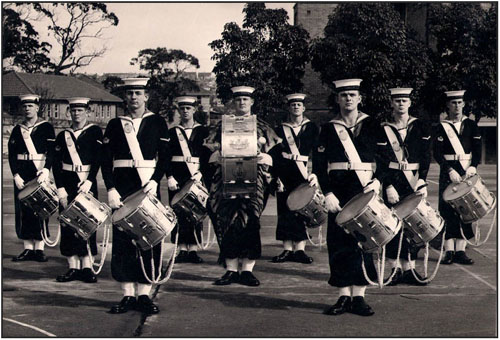 Following lengthy negotiations regarding finance between the various State and Federal Governments, it was agreed in January 1963 to award a contract to the Australian music company, Drouyn & Drouyn of Brisbane to construct:
Following lengthy negotiations regarding finance between the various State and Federal Governments, it was agreed in January 1963 to award a contract to the Australian music company, Drouyn & Drouyn of Brisbane to construct:
1 Bass drum and 4 Side drums to be financed by The Commonwealth.
1 Side drum each to be financed by South Australia, Western Australia, Queensland and Tasmanian Governments.
1 Tenor drum each to be financed by New South Wales and Victorian Governments.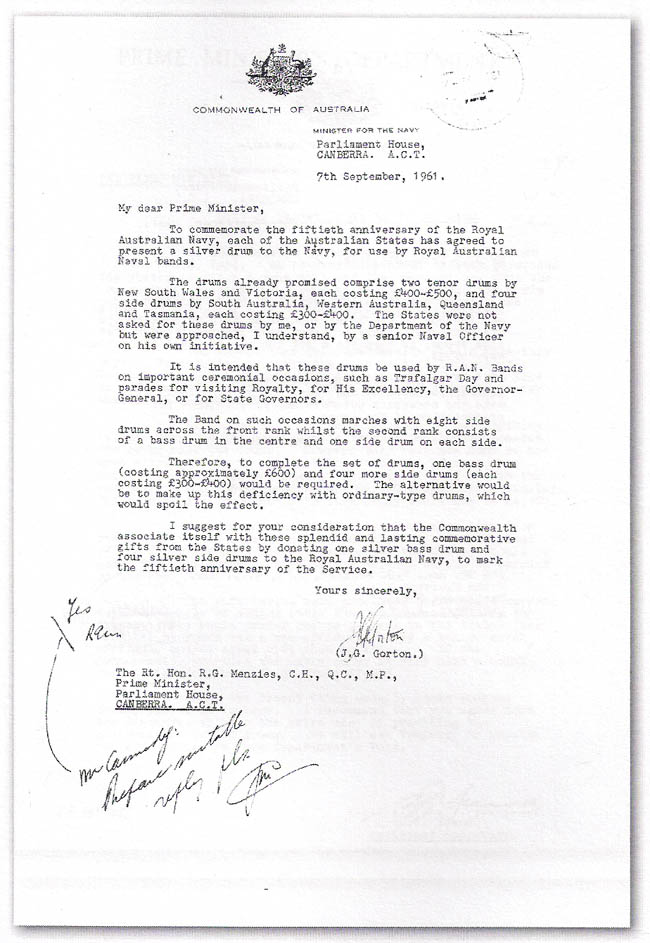
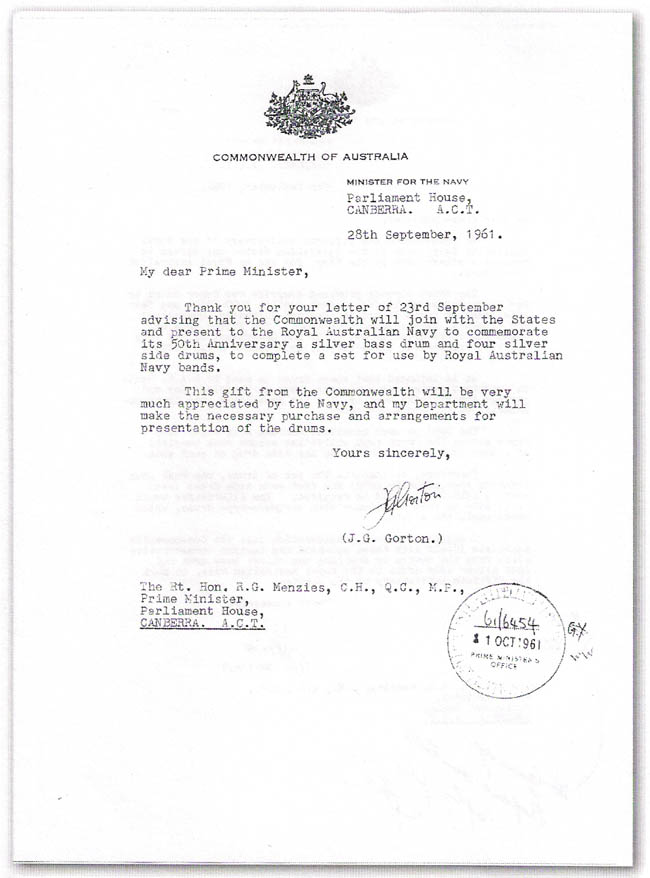
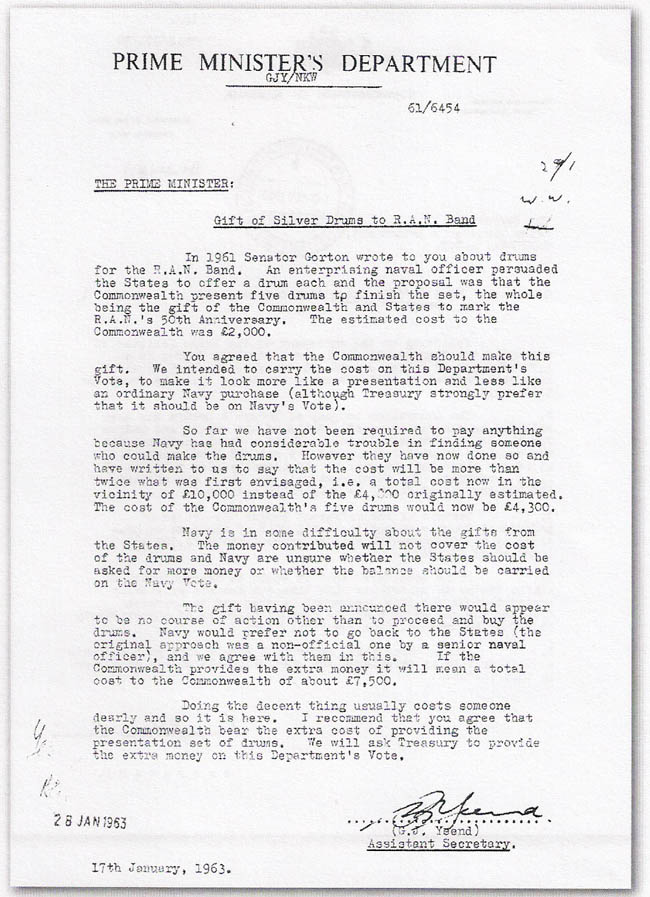

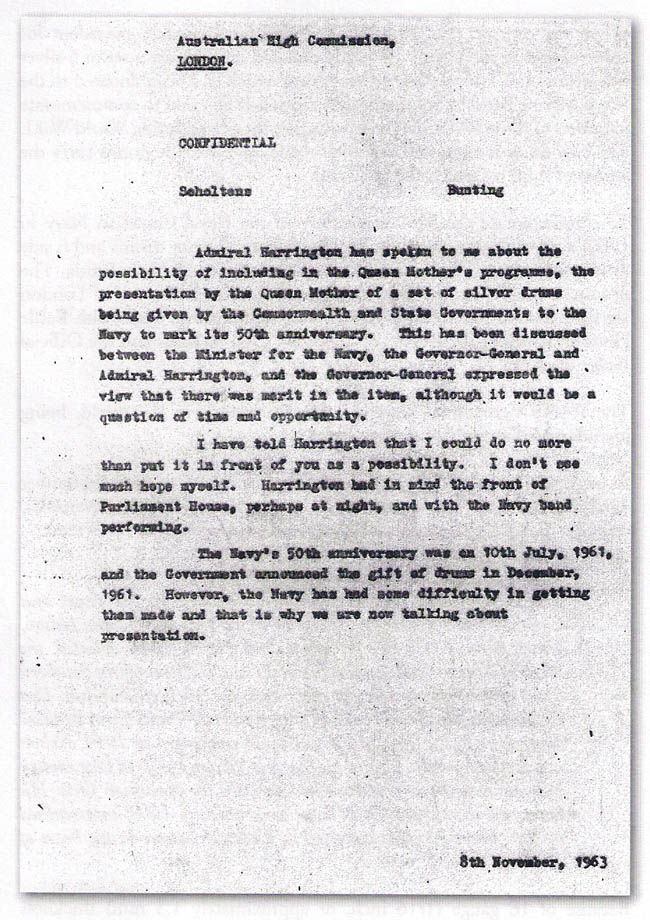
When the contract was awarded there was no Australian precedent for construction of such items. Similarly donated drums were a
set of 5 silver side drums and 1 silver finished bass drum which had been donated to the Royal Marine Band by voluntary subscription of all ranks to commemorate members of those RMSOM ranks who gave their lives during World War I. The bass drum is engraved with their names and the side drums carry the names of ships on which the men died.
To commemorate the 50th Anniversary of the Royal Canadian Navy in 1960, a set of drums consisting of a bass drum, 2 tenor drums and 6 side drums was presented to the RCN by the Province of Nova Scotia. The drums, manufactured by the Boosey and Hawkes Company of London are the standard rope tension model with sterling silver shells with Battle Honour Scrolls of the RCN, the Canadian Coat of Arms and the Official Badge of the RCN.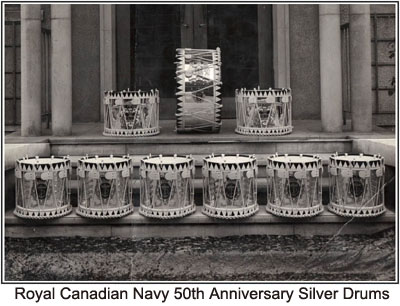
The RAN’s Ceremonial Silver Drums are unique in the world, being manufactured entirely of sterling silver.
As suggested by John Gorton, the Minister for the Navy on 7 September 1961 the drums, if manufactured could be paraded for “important ceremonial occasions such as Trafalgar Day and on special occasions such as Royal visits”.
Trafalgar Day
He is immortalised by the Nelson monument erected in Trafalgar Square in the heart of London.
Because of 16 gauge (1/16 inch, or approximately 1.5 mm) thickness and quality of the silver used in their construction, the drums are very heavy and can only be used for short ceremonial occasions. The first time they were paraded was at The British Military Tournament and Tattoo in the Sydney Showground 23 September 1964 - 10 October 1964 when a Ceremonial Drill Display by the Royal Marine Commandos was accompanied by the Royal Australian Navy Band.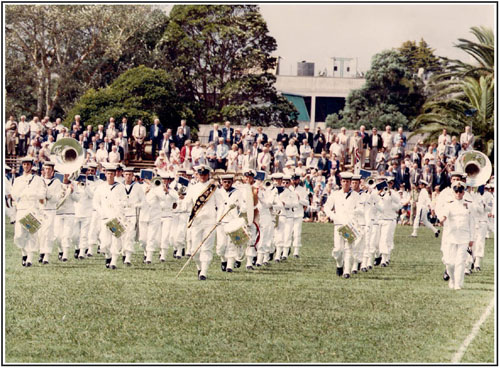
They have since been used on many ceremonial occasions including the Navy’s 75th Anniversary in 1986.
The latest overseas display was the Brunei International Tattoo in 2006.
The drums are exhibited at The Naval Heritage Centre Garden Island Sydney in a specially designed and sealed glass showcase
which inhibits tarnishing. Gloves must be worn when handling the drums to avoid surface stains.
Awarding the Contract:
The contract for the manufacture of the drums stipulated that they must be built by an Australian company. In the early 1960s there were very few musical instrument makers let alone drum manufacturers in Australia. However, the Brisbane Company of Drouyn & Drouyn met all the requirements and was thus awarded the contract in January 1963.
Acceptance should have been quick and easy. However family circumstances at the time had been overshadowed by Douglas Drouyn, the Principal and founding partner of Drouyn & Drouyn suffering a fatal heart attack in February. Following this setback discussions took place between family members and the loyal staff of 8 of whom 4 were very experienced craftsmen. The bank offered continuation of financial support, the decision to go ahead with the contract was made and a production plan drawn up.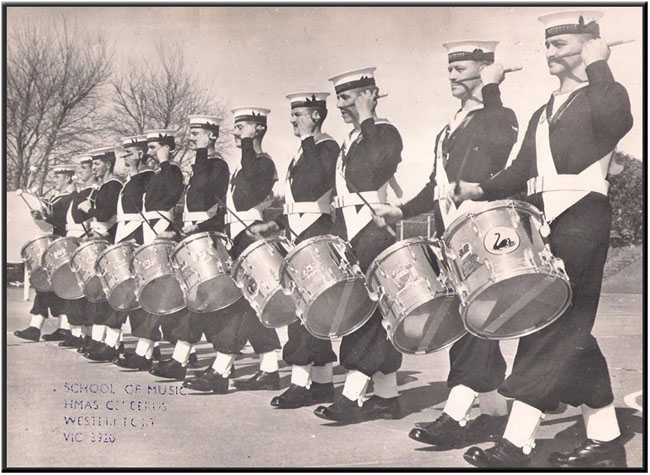
One of the initial problems was to find a bullion dealer who could deliver such a large quantity of sterling silver. The Sydney based firm of Mathey Garrett came to the rescue. The silver was ordered in March and delivered in June. One of Drouyn’s existing sub- contractors, Handford Industries began the roll forming of drum shells and counter hoops.
A representative of the company had visited HMAS Cerberus in May (1963) to discuss all the technical requirements with Lieutenant Commander George Hooker, the Navy’s Director of Music. On his return to Brisbane the company then had only five months in which to complete construction for delivery in December 1963.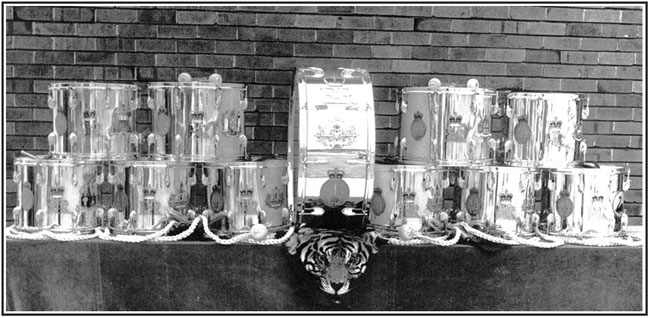
The other sub-contractors utilised were:
1) Wallace Bishops, Manufacturing Jeweller who designed and manufactured the various Commonwealth and State Crests and Badges and the Royal Insignia.
2) Eastgate Engineering who carried out the metal pressing and manufacture of various small components.
3) AW Bonham & Co. manufacturers of tension rods who were tasked with producing the product out of sterling silver for the first time in history.
4) M Simonson & Co. who produced the tension barrels and castings at their Sydney foundry.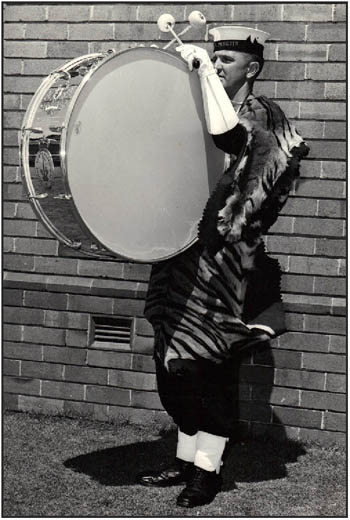
5) Jolly & Batchelor who tanned and produced the leather for the drum slings.
6) Leo White – Sydney, the Australian agent for Remo plastic drum heads (made in USA), provided batter and snare heads for all drums.
7) The 16 strand silver plated wire snares were made in the Drouyn factory.
8) The sticks were made out of Queensland Black Bean timber fitted with sterling silver ferrules and butt end caps.
By October all manufacturing had been successfully completed and all silver components were buffed and polished prior to final assembly.
By November all final assembly was completed on time for the final acceptance inspection at the Stones Corner factory.
In November 1963 Rear Admiral Harrington had suggested that the drums could be formally presented to the Navy by the Queen
Mother during her forthcoming visit to Australia. To quote from a cable sent to the Australian High Commission, London:
”Harrington had in mind the front of Parliament House, perhaps at night, with the Navy Band performing”.
The Royal Schedule however did not allow this proposition to be realised, so the drums were formally presented by Premiers or their Deputies at various state ceremonies.
On 6 December 1963 the first of the State Presentations took place in Sydney before Rear Admiral Gatacre and the Deputy Premier of New South Wales, Pat Hills. 
Bands of the RAN then travelled throughout the country for various State Presentations.

The Ceremonial Silver Drums are a permanent tribute to the RAN’s 50th Anniversary in 1961 and an excellent example of Australian enterprise and manufacture demonstrated by the Drouyn & Drouyn Company.
Douglas Drouyn, a professional musician, in partnership with his sister Dorothy had opened a small music shop in South Brisbane in 1927. Apart from supplying the music trade, the shop also encompassed a musical instrument repair section plus tuition facilities.
The shop was forced by the depression to cease trading in 1931, however prior to WWII, a new shop was opened in Stone’s Corner Brisbane. During the war the importation of musical instruments ceased and repairs to existing instruments became important. 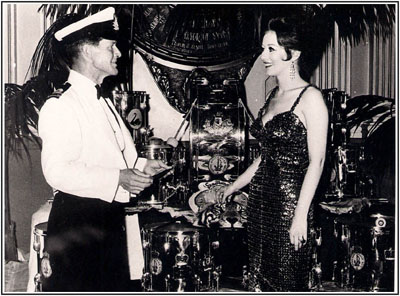
In 1942 the Dandy Drum Company was established in response to a wartime shortage to supply drums to the Australian Armed Forces. Because of the demand, at the same time a “war priority” was awarded to the company to repair US Navy Band instruments.
Drum manufacture (under the Dandy name) continued and when the contract to build the silver drums was awarded in 1963, it provided an opportunity to demonstrate the Australian tradition of “have a go” overcoming all the inherent difficulties to produce a lasting example of skilled manufacture. Every component of each drum; shell, counter hoops, tension brackets and screws, snare releases and the actual snares, crests and badges are fabricated of sterling silver.
A visit to The Naval Heritage Centre Garden Island Centre Sydney to view these magnificent drums is thoroughly recommended.
Some interesting statistics:
Sheet sizes for drum shells –
Side drum 14” x 14” (355 mm x 355 mm) circumference 44” (1.12 m)
Tenor drum 16” x 14” (450 mm x 355 mm) circumference 50” (1.27 m)
Bass drum 28” x 12” (710 mm x 305 mm) circumference 88” (2.24 m)
Weight overall (approximate)
Side drum 12 kg
Tenor drum 18 kg
Bass drum 25 kg
Thickness of silver
16 gauge = 1/16” or 0.0625”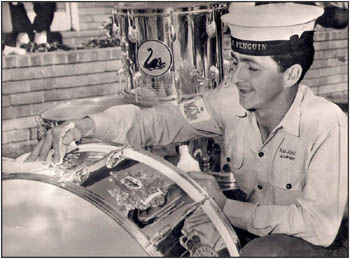
Each drum is engraved with the text –
“Presented by the ……. Government to the Royal Australian Navy on the occasion of its 50th Anniversary 10 July 1961.
Badge “Supplied by Dandy Drouyn & Drouyn”
Each drum has –
Royal Crest.
RAN Crest.
State/Federal Crest.
The recent value for Government Insurance Survey was $1.8 million dollars. However at current world silver prices, the current value would exceed that.
Robin Himbury.
